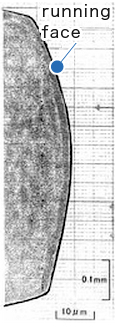Piston Ring Function
B-4 Top Ring
Looking at a typical ring set for today's automotive engine application, we'll first examine the Top Ring.
Shown is a top ring for an 86mm diameter cylinder bore. The ring's axial width (height) is 1.2mm and its radial thickness is 3.1mm. The ring in the photo is shown in the so-called "free state", that is, what the ring looks like before installation into the engine. The 'free gap' (open portion of the ring) is about 9mm.
When the ring is installed (on the piston) in the engine, it is 'squeezed' closed to its effective diameter of 86mm. Since the ring wants to expand back to its free state, this built-in 'springiness' makes the ring fit tightly against the cylinder wall. The force needed to close the ring to 86mm can be measured and is usually called 'ring tangential tension'. Tangential tension is an important ring characteristic and is always considered carefully during the design phase.
Looking at the outside shape of the ring, we see the peripheral working face *1 (or 'running face') of the ring. This 'running face' stays in contact with the cylinder wall, usually cushioned on a thin layer of oil. This surface 'slides' on the cylinder wall and some resistance, called sliding friction, is generated.


Here we show a profile of the ring's 'running face' magnified 1000 times. Under magnification, the surface appears to be composed of minute convex spherical surfaces. This surface shape plays an important role in forming an oil film during high-speed operation. A hard film of CrN (nitrided chromium) is formed on the running face by an ion plating (known as "PVD") process. Other surface treatments for the ring's running face include nitirding and hard chrome plating.
- *1 The working or contacting face refers to that portion of the ring that is sliding in contact with other surfaces.






